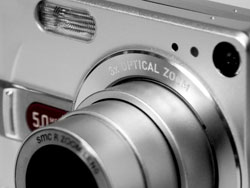How Does a Digital Camera Work?

Digital photography is quickly banishing the old film camera to the dust heap of history, and more and more people are
discovering the many advantages of taking their photos the digital way. From ease of sharing to no more wasted film, digital
photography certainly has many advantages. There are a few basic things every new digital photographer must know, however.
When shopping for a digital camera, you will encounter strange terms like megapixels, dpi, optical zoom and digital zoom.
It is important to understand what these terms mean to you.
Pixels and Megapixels
The term pixel stands for picture element. All digital images consist of a number of small squares. Even though the
resulting image looks smooth, it is actually made up of millions of these tiny squares.
When you shop for a digital camera you will need to look at the megapixel count. Mega means million, with most
mass market digital cameras on the market rated at between 1 and 6 megapixels, sometimes abbreviated as 1 MP, 2 MP,
etc.
The megapixel count you need will be determined by what size prints you are likely to want. For instance, a camera rated
at 3MP will make great 4"x6" prints and quite good 5"x7" prints. If you plan on making lots of 8"x10" and larger prints,
you may want to look at cameras rated at 4MP, 5MP or higher.
Digital Zoom Versus Optical Zoom
You will see two different zoom ratings as you shop for digital cameras — optical zoom and digital zoom. You can ignore
the digital zoom rating, as digital zoom is simply a software trick in which you can enlarge certain elements of the
picture to zoom in an image. Any good photo editing software will include a digital zoom feature, so there is no need to
have it on the camera as well. Pay no attention to a high digital zoom number.
The optical zoom, however, is a true zoom, similar to the zoom lens on a 35mm film camera. Here you do want a
large number. Try to look for a 10x or better optical zoom. There are a number of excellent cameras on the market
with 10x, 15x and even 20x optical zooms. If you plan to photograph sporting events, concerts, or similar events, a
good optical zoom is a must.
The amount of memory that comes with your digital camera will determine the number of pictures it can hold. Unlike a
film camera, when the memory card on a digital camera fills up, all you need to do is transfer the pictures it holds,
either to actual physical prints, copying them to your computer, or both. You are then free to reuse the memory card again
and again.
There are a number of different memory cards on the market, and each type of camera will come with a different
type of memory. When shopping for additional memory, it is important to choose the type that matches your camera.
The available types of digital camera memory are compact flash (CF), Secure Digital (SD), Memory Stick and Multi
Media Cards (MMC).
The following table shows how many prints each amount of memory will hold:
|
3MP |
4MP |
5MP |
6MP |
128MB |
116 |
87 |
70 |
58 |
256MB |
232 |
174 |
140 |
116 |
512MB |
464 |
348 |
280 |
232 |
Getting the Shots off the Camera
Of course taking those great shots is only half the battle. You will need a quick and easy way to transfer
those great images to your computer. Most digital cameras will come with a USB cable for connecting the camera to
the computer. If your computer was purchased within the last three or four years, chances are it contains at least
one or two USB ports, and this makes connecting the camera a snap.
Many camera manufacturers also sell docking cradles, either as an extra accessory or included with the camera. These
docking cradles can be very convenient, since you simply snap your camera into the cradle and transfer the pictures right
to your PC. The docking cradle also doubles as a charger for the camera's batteries.
|